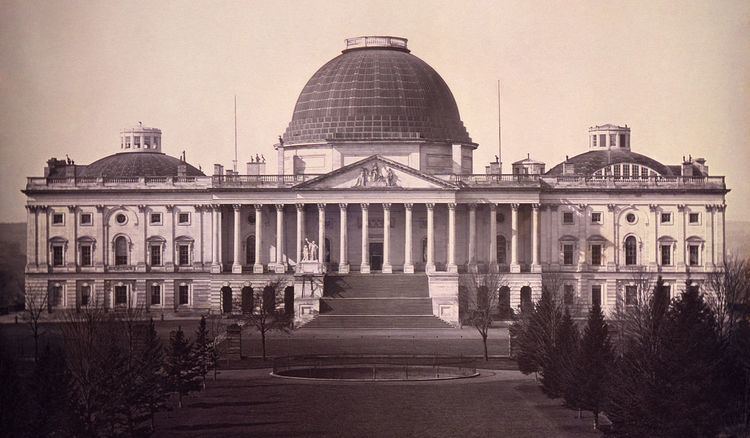The Thirty-second United States Congress was a meeting of the legislative branch of the United States federal government, consisting of the United States Senate and the United States House of Representatives. It met in Washington, D.C. from March 4, 1851 to March 4, 1853, during the third and fourth years of Millard Fillmore's presidency. The apportionment of seats in the House of Representatives was based on the Sixth Census of the United States in 1840. Both chambers had a Democratic majority.
March 20, 1852: Uncle Tom's Cabin publishedJuly 1, 1852: Henry Clay was the first to lie in state in the United States Capitol rotundaNovember 2, 1852: U.S. presidential election, 1852: Democrat Franklin Pierce defeated Whig Winfield Scott[Data unknown/missing. You can help!]March 2, 1853: Washington Territory was formed from Oregon Territory.President: Vacant (since the ascension of Millard Fillmore to U.S. President on July 9, 1850)President pro tempore: William R. King (D), until December 20, 1852David R. Atchison (D), from December 20, 1852Speaker: Linn Boyd (D)This list is arranged by chamber, then by state. Senators are listed in order of seniority, and Representatives are listed by district.
Senators were elected by the state legislatures every two years, with one-third beginning new six-year terms with each Congress. Preceding the names in the list below are Senate class numbers, which indicate the cycle of their election. In this Congress, Class 1 meant their term began with this Congress, requiring reelection in 1856; Class 2 meant their term ended with this Congress, requiring reelection in 1852; and Class 3 meant their term began in the last Congress, requiring reelection in 1854.
Skip to House of Representatives, belowThe names of members of the House of Representatives are preceded by their district numbers.
The count below reflects changes from the beginning of the first session of this Congress.
replacements: 8Democrats (D): 1 seat net gainWhigs (W): 1 seat net lossdeaths: 3resignations: 6interim appointments: 3Total seats with changes: 13replacements: 6Democrats (D): 1 seat net lossWhigs (W): 1 seat net gaindeaths: 2resignations: 5Total seats with changes: 7Lists of committees and their party leaders.
AgricultureAudit and Control the Contingent Expenses of the SenateClaimsCommerceContested Election of 1850Distributing Public Revenue Among the States (Select)District of ColumbiaEmigrant Route and Telegraphic Line to California (Select)Ether Discovery (Select)FinanceForeign RelationsFrench Spoilations (Select)Indian AffairsJudiciaryManufacturesMexican Boundary (Select)Mexican Boundary Commission (Select)Mexican Claims Commission (Select)Military AffairsMilitiaNaval AffairsOrdnance and War Ships (Select)Patents and the Patent OfficePensionsPost Office and Post RoadsPrintingPrivate Land ClaimsPublic Buildings and GroundsPublic LandsPurchase of Catlin's Collection of Indian Scenes (Select)RetrenchmentRevolutionary ClaimsRoads and CanalsTariff Regulation (Select)TerritoriesSeventh Census (Select)WholeAccountsAgricultureBounty Land Act of 1850 (Select)ClaimsCommerceDistrict of ColumbiaElectionsEngravingExpenditures in the Navy DepartmentExpenditures in the Post Office DepartmentExpenditures in the State DepartmentExpenditures in the Treasury DepartmentExpenditures in the War DepartmentExpenditures on Public BuildingsForeign AffairsIndian AffairsInvalid PensionsManufacturesMileageMilitary AffairsMilitiaNaval AffairsPatentsPost Office and Post RoadsPublic Buildings and GroundsPublic ExpendituresPublic LandsRevisal and Unfinished BusinessRevolutionary ClaimsRoads and CanalsRulesStandards of Official ConductTerritoriesWays and MeansWholeEnrolled BillsArchitect of the Capitol: Thomas U. Walter, appointed June 11, 1851Librarian of Congress: John Silva MeehanChaplain: Clement M. Butler (Episcopalian)Secretary: Asbury Dickens elected December 12, 1836Sergeant at Arms: Robert Beale, elected December 9, 1845Chaplain: Littleton F. Morgan (Methodist), elected December 1, 1851James Gallagher (Presbyterian), elected December 6, 1852Clerk: John W. ForneyDoorkeeper: Zadock W. McKnewSergeant at Arms: Adam J. GlossbrennerPostmaster: John M. Johnson 
